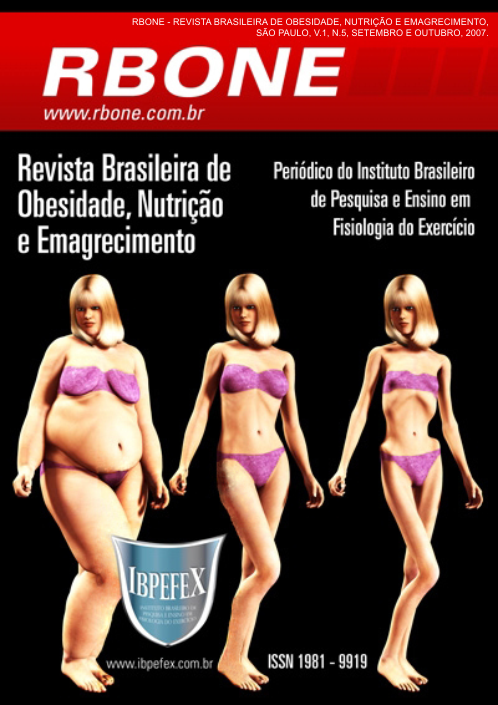The importance of the orientation and re-education nutritional in the treatment of the obesidade
Abstract
To analyze obesity treatment based on nutritional appointment and orientation, in which patients are suggested to adopt appropriate alimentary habits and changes in life style. Material and Methods: 160 appointments with patients between 6 and 48 years were accomplished. Overweight or obesity were defined based on the body mass index (BMI). Results: At the first appointment, 19% of the patients were classified as eutrophic, 43% as overweight and 38% as obese. After five months of follow-up this panorama changed from 19% to 36%, 43% to 34% and 38% to 30%. The changes were more significant among men. Discussion: The present paper demonstrates an increase in overweight and obese patients, which is directly related to sedentary life style and inappropriate alimentary habits. The main result observed was the waste of macro-nutrients identified through individual appointments. After orientation and observation of each patient’s nutritional status for five months, the results were satisfactory. Conclusion: It is possible to treat obesity through alimentation adjustment, replacing hypercaloric foods with nutritive hypocaloric ones and promoting balanced diets.
References
- Blundell, J.E.; Hill, A.J. Biopsychological interactions underlying the study and treatment of obesity. In M. J.; Christie e P.G.; Mellett (Eds.), The psychological Approach: Contemporary Practice of Whole-personal Care. 1986. pp. 115-135: chichester. John Wiley e Sons.
- Brownell, K.D.; O`Nell, P.M. Obessidade. In. D. H. Barlow (Org). Manual Clínico dos Transtornos Psicológico. Porto Alegre. Artemed. 1999. p. 355-403.
- Conti`, M.A.; Frutuoso, M.F.P.; Gambardella, A.M.D. Excesso de peso e insatisfação corporal em adolescentes. Campinas. Revista. De Nutrição. Vol. 18. Num. 4. Jul. / ago. /2005 p. 491-497.
- Fisberg, M. Obesidade na infância e adolescência. São Paulo, Revista. bras. Educ. Fís. Esp., Vol. 20. Num 5. set. /2006 p. 163-164.
- Fujimoto, W.Y.; Bergstron, R.W.; Boiko, E.J.; Chen, K.; Leonetti, D.; Newell-Morris, e Colaboradores. Visceral adiposity and incident coronary heart disease in Japanese-American men. Diabetes Care. Vol. 22(11). 1999. p. 1808-12.
- Lotterberg, S.A. Obesidade. In: MAGNONI, D.; CUKIER, C. Perguntas e Respostas em Nutrição Clínica. 2ª edição. São Paulo. ROCA. 2005. p. 350-359.
- Luiz, A.M.A.G.; Gorayeb, R.; Júnior, R.D.R.L.; Domingos, N.A.M. Depressão, ansiedade, competência social e problemas comportamentais em crianças obesas: Universidade de São Paulo, Ribeirão Preto e Faculdade de Medicina e Enfermagem de São José do Rio Preto. Estudo de psicologia. 10(3). 2005. p. (371-375).
- Oliveira, A.M.A.; Cerqueira, E.M.M.; Sousa, J.S.; Oliveira, A.C. Sobrepeso e Obesidade Infantil: Influência de Fatores Biológicos e Ambientais. Departamento de Saúde, Universidade Estadual de Feira de Santana (UEFS), Feira de Santana BA. Arq.bras endocrinol metab. Vol. 47. Num. 2. Abril/2003. p. 144-150.
- Oliveira, C.L.; Fisberg, M. Obesidade na infância e adolescência -uma verdadeira epidemia. São Paulo. Arquivo Brasileiro Endocrinol Metab. Vol. 47. N°. 2. 2003. Pág. 1-4.
- Peña, M.; Bacallao, J. La obesidad en la pobreza: Un nuevo reto para la salud pública.
Publicação Científica, Washington (DC): OPS, nº 576, 2000.
- Pereira, S. Projeto de intervenção em crianças e adolescentes obesas. Porto, Portugal. Art. Científico Publicado nos Arquivos de Medicina. 2006. p. 1-14.
- Phillippi, S.P.; Latterza, A.R.; Cruz, A.T.R.; Ribeiro, L.C. Pirâmide Alimentar Adaptada: Guia para Escolha dos Alimentos. Campinas. Revista. Nutrição. Vol. 12(1). 1999. p. 65-80.
- Rêgo, A.L.V.; Chiara, V.L. Nutrição e Excesso de Massa Corporal: Fatores de risco Cardiovascular em Adolescentes. Campinas. Nov/Dez2006 Revista. Nutri. Vol. 19(6). P. 702-712.
- Rosenbaum, M.; Leibel, R.L. The physiology of body weight regulation: relevance to the etiology of obesity in children. Pediatrics. 1998. Vol. 101 Num. 3. p. 525-39
- Silva, G.A.P.; Balaban, G.; Motta, M.E.F.A. Prevalência de Sobrepeso e Obesidade em Crianças e Adolescentes de Diferentes Condições Socioeconômicas. Recife. Revista. Bras. Saúde Matern. Inf. Vol. 5. Num. 1. jan/Mar/2005. p. 53-59.
- Styne, D.M. Childhood and adolescent obesity. Prevalence and significance. Pediat Clin North Amer. Vol. 48. 2001. p. 823-53.
- Teichmann. L.; Olinto, M.T.A.; Costa, J.S.D.; Ziegler, D. Fatores de Risco Associados ao Sobrepeso e a Obesidade em Mulheres de São Leopoldo. RS. Revista. Bras Epidemiol. Vol. 9. Num. 3. 2006. p. 360-373.
- Terres, N.G.; Pinheiros, R,T.; Horta, B.L.; Pinheiro, T.A.K.; Horta, L.L. Prevalência e Fatores Associados ao Sobrepeso e à obesidade em Adolescente. Pelotas, RS, Brasil. Revista. Saúde pública Vol. 40. Num 4. Ano 2004. p. 01-07
- WHO -World Health Organization. Obesity- Preventing and managing the global epidemic. Geneva. 1997.
- World Heealth Organization. Obesity: preventing and managing the global epidemic. Report Of a WHO Consultation on Obesity. Geneva: WHO; 1988.
Authors who publish in this journal agree to the following terms:
- Authors retain the copyright and grant the journal the right of first publication, with work simultaneously licensed under the Creative Commons Attribution License BY-NC which allows the sharing of the work with acknowledgment of the authorship of the work and initial publication in this journal.
- Authors are authorized to enter into additional contracts separately for non-exclusive distribution of the version of the work published in this journal (eg, publishing in institutional repository or book chapter), with acknowledgment of authorship and initial publication in this journal.
- Authors are allowed and encouraged to post and distribute their work online (eg, in institutional repositories or on their personal page) at any point before or during the editorial process, as this can bring about productive change as well as increase impact and impact. citation of published work (See The Effect of Free Access).






